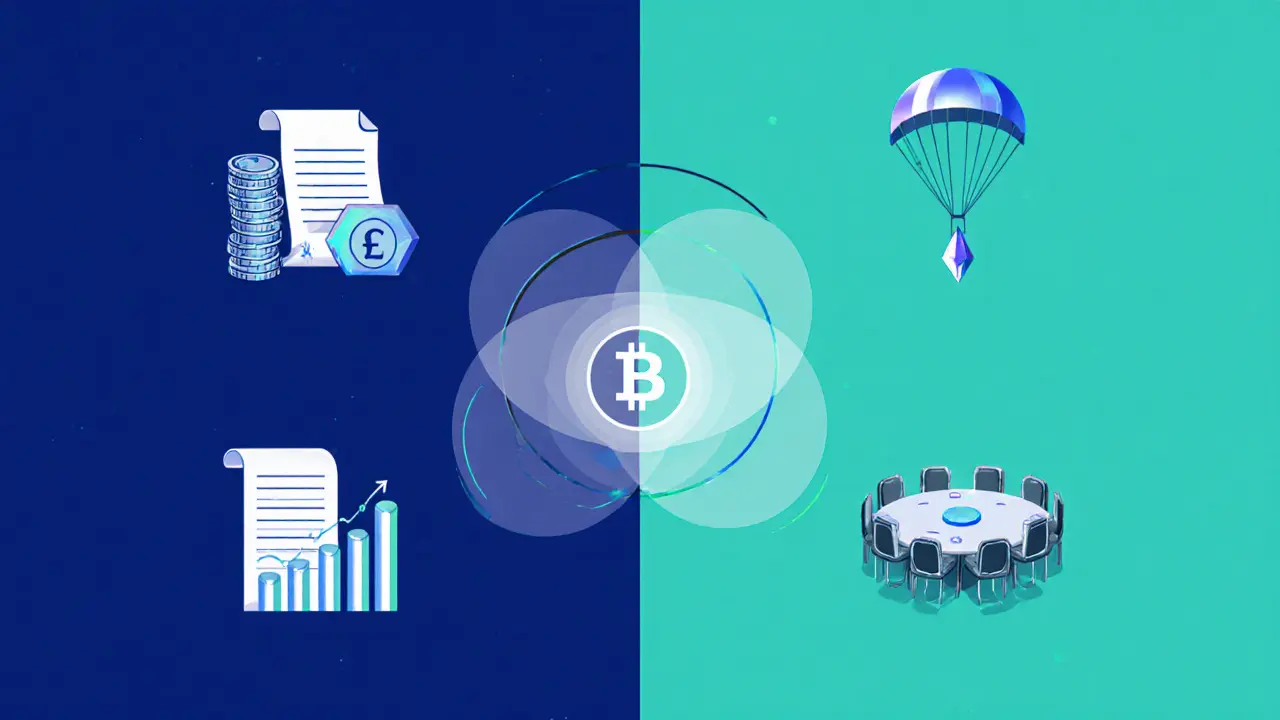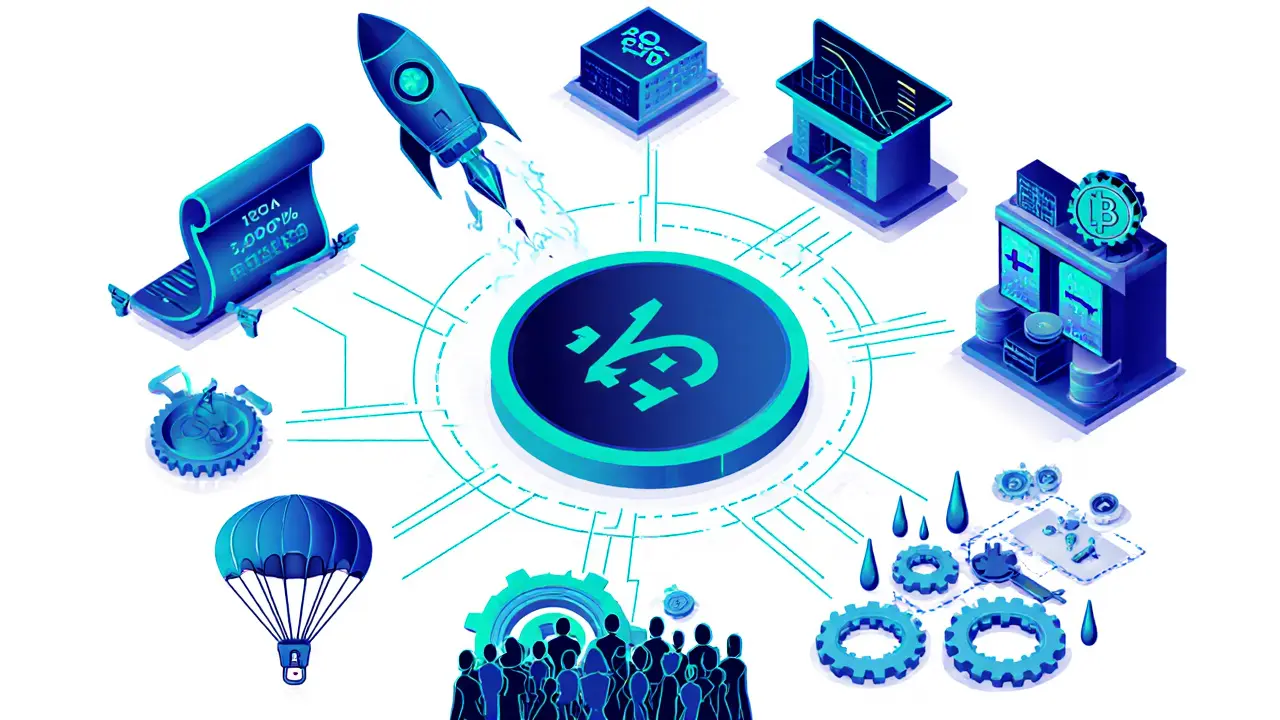Nov 13, 2024, Posted by: Ronan Caverly

Utility Token Distribution Model Selector
Distribution Model Families
Choose one of the two main distribution model families based on your project needs:
Paid Models
Raise capital through token sales
ICOs, IEOs, SAFTs, Launchpads
Free Models
Distribute tokens without payment
Airdrops, Staking, DAO Governance
Key Decision Criteria
Need immediate capital? Not selected
Target strict jurisdictions? Not selected
Rapid community onboarding? Not selected
Strong governance needed? Not selected
KYC/AML implementation? Not selected
Model Features Comparison
Select a distribution model family to see detailed features
Decision Checklist
Recommended Approach
Your selection will appear here once you make decisions.
Quick Takeaways
- Utility token distribution models dictate how tokens reach investors, teams, and community members.
- Two main families: paid (e.g., SAFT, ICO, IEO) and free (e.g., airdrops, staking rewards).
- Regulatory compliance matters most for paid models; anti‑whale caps matter most for free models.
- Hybrid approaches combine paid fundraising with community incentives for balanced tokenomics.
- Use a clear decision checklist to match model features with project goals and jurisdictional rules.
Utility Token Distribution Models are the strategic blueprints that decide who gets a project's native tokens, when, and under what conditions. They sit at the heart of tokenomics, shaping trust, liquidity, and long‑term sustainability in any Web3 ecosystem.
What Exactly Is a Utility Token Distribution Model?
At its core, a distribution model answers three questions:
- Which stakeholder groups receive tokens?
- How many tokens does each group receive?
- What mechanisms enforce the allocation?
- Regulatory landscape: Paid models must survive securities tests (Howey, 2020 SEC guidance). Free models should still avoid being deemed “investment contracts” if they promise profit.
- Fairness & anti‑whale mechanics: Caps per wallet, tiered pricing, and randomized airdrop proofs can stop token hoarding.
- Economic sustainability: Inflation from staking or liquidity mining must be balanced against token utility (e.g., voting power, fee discounts).
- Transparency: Smart contracts should be open‑source, audited, and provide on‑chain logs of allocation events.
- Community alignment: Early contributors should feel rewarded, but insiders must retain enough stake to steer the roadmap.
- Over‑allocating to insiders: Keeps whales happy but scares community investors. Keep founder vesting under 20% and enforce cliff periods.
- Ignoring inflation: Unlimited liquidity mining erodes token value. Set a hard cap on minted rewards or use a decreasing emission schedule.
- Skipping legal review: Even a tiny airdrop can trigger securities scrutiny if it promises profit. Consult counsel early.
- Complex smart contracts: More lines of code mean higher audit costs and more bugs. Keep allocation logic as simple as possible.
- One‑size‑fits‑all pricing: Fixed‑price sales attract whales. Use tiered or Dutch auction formats to level the playing field.
- Map every stakeholder group (investors, team, validators, users).
- Assign a tentative percentage to each group, respecting a 50‑70% community share.
- Select a primary paid mechanism (SAFT, IEO, launchpad) if you need cash.
- Design a complementary free mechanism (airdrop, staking, DAO token).
- Draft the allocation smart contract, then run a formal security audit.
- Prepare legal opinions for the chosen jurisdiction(s).
- Publish a transparent tokenomics whitepaper and share the on‑chain allocation dashboard.
The answer influences everything from early fundraising success to post‑launch governance. A well‑crafted model minimizes centralization, satisfies regulators, and creates lasting incentives for developers, investors, and community members.
Two High‑Level Families: Paid vs. Free
Most projects split their token release into paid and free streams. Paid streams generate capital; free streams reward participation and promote decentralization.
| Aspect | Paid Models | Free Models |
|---|---|---|
| Typical price | Tokens sold for fiat or crypto | No direct payment required |
| Regulatory exposure | High - securities law, AML/KYC | Low - often considered airdrop/utility |
| Primary participants | Investors, venture funds, early backers | Community members, validators, DAO voters |
| Common mechanisms | SAFT, ICO, IEO, launchpad sales | Airdrops, staking rewards, liquidity mining |
| Typical allocation size | 10‑30% of total supply | 70‑90% of total supply |
Paid Distribution Mechanisms
When a project needs cash to build, it leans on a paid model. Below are the most common structures.
SAFT (Simple Agreement for Future Tokens)
SAFTs let investors fund a project before tokens exist. The contract records a percentage allocation, not a fixed token count. Because tokens are unissued, SAFTs can stay outside securities definitions in some jurisdictions, but they still demand thorough KYC/AML verification.
Token Sale Agreement
Once tokens are minted, a Token Sale Agreement replaces the SAFT. It details exact token quantities, price tiers, and vesting schedules. Compliance teams use it to document investor eligibility and to demonstrate that anti‑money‑laundering steps were taken.
Initial Coin Offering (ICO)
ICOs opened the token fundraising floodgate around 2017. They allow anyone to buy tokens with Bitcoin, ETH, or stablecoins. Minimum contributions are often low, which boosts participation but also attracts speculation. Because ICOs lack a central exchange intermediary, regulators view them as high‑risk securities offerings.
Initial Exchange Offering (IEO)
IEOs move the sale onto a compliant exchange. The exchange screens investors, holds the funds in escrow, and distributes tokens automatically after the sale ends. This extra layer reduces fraud risk and usually improves post‑sale liquidity.
Launchpad Sales
Launchpads are curated platforms (e.g., Binance Launchpad, Polkastarter) that run tiered sales. They often enforce allocation caps per wallet to curb whale behavior. Projects benefit from the launchpad’s built‑in community and marketing reach.
Liquidity Bootstrapping Pool (LBP)
LBPs use a dynamic price curve that gradually lowers token price while the pool's token weight shifts. This method discourages front‑running and gives price discovery a fairer start. It’s a hybrid of a sale and an AMM, preserving liquidity for day‑one trading.

Free Distribution Mechanisms
Free models don’t raise capital directly, but they are vital for network effects and decentralized governance.
Founder & Team Allocations
Founders typically receive a fixed percentage (often 10‑20%) that vests over 12‑48 months. Vesting aligns incentives and prevents a sudden flood of sell pressure after launch.
Airdrops
Airdrops broadcast tokens to a pre‑selected list-wallets that held a certain asset, participated in a prior testnet, or completed a KYC. They generate buzz and bring users onto the platform without demanding a purchase.
Staking Rewards
Projects lock tokens in a staking contract and reward validators or delegators with newly minted tokens. The reward rate is usually expressed as an annual percentage yield (APY) and must be calibrated to avoid runaway inflation.
Liquidity Mining
Liquidity providers earn utility tokens for supplying pairs on a decentralized exchange. The reward schedule often follows a decreasing curve to incentivize early liquidity while gradually handing off to market‑driven fees.
DAO Governance Tokens
DAOs allocate tokens to active contributors, proposal creators, and voters. Governance tokens empower holders to decide on fund allocation, protocol upgrades, and parameter tweaks, turning the community into a de‑facto board of directors.
Design Considerations That Make or Break a Model
Choosing a distribution scheme isn’t just about picking a name. You need to evaluate several dimensions.
How to Pick the Right Model for Your Project
Use the checklist below. Answer each item with “Yes” or “No”. If you get more “Yes” in a column, that column’s model family is a better fit.
| Criteria | Paid Model Suitability | Free Model Suitability |
|---|---|---|
| Need immediate capital for development? | Yes | No |
| Target jurisdictions with strict securities laws? | No (high risk) | Yes (lower exposure) |
| Goal is rapid community onboarding? | No (price barrier) | Yes (airdrop, staking) |
| Require strong governance participation? | Partial (can issue governance tokens later) | Yes (DAO token distribution) |
| Willing to implement KYC/AML pipelines? | Yes | No (optional) |
If you need capital **and** want a healthy community, consider a hybrid: run a capped private SAFT round for 15% of supply, then launch an airdrop + staking program for the remaining 85%.
Common Pitfalls and How to Avoid Them
Next Steps for Token Designers
Following this roadmap helps you launch a token that raises money, attracts users, and stays compliant for years to come.

Frequently Asked Questions
What is the difference between a SAFT and an ICO?
A SAFT is a contract signed before any tokens exist; it promises a future token allocation based on a percentage. An ICO sells already‑minted tokens directly to the public, often at a fixed price, and typically involves lower regulatory thresholds but higher speculative risk.
Can I run an airdrop without violating securities laws?
If the airdrop does not promise profit based on the token’s future value and is given without any purchase requirement, many jurisdictions treat it as a non‑security distribution. However, local regulations differ, so a brief legal check is still recommended.
How do anti‑whale caps work in practice?
Caps can be set per wallet (e.g., max 2% of total supply) or per transaction (e.g., max $10,000 worth per trade). Smart contracts enforce these limits at the moment of purchase or claim, automatically rejecting excess amounts.
What is a Liquidity Bootstrapping Pool and why use it?
An LBP starts with a high token weight that gradually decreases, causing the price to drop over time. This dynamic pricing reduces front‑running, gives early liquidity providers a better entry price, and creates organic price discovery before the token hits a regular AMM.
Should I issue governance tokens separately from utility tokens?
Separating them can simplify regulatory treatment-governance tokens often qualify as non‑transferable voting rights. However, many projects merge utility and governance into a single token to lower complexity. Choose based on your legal counsel’s advice and community design goals.
Write a comment
Comments
Joel Poncz
I grabbed the quick takeaways and bookmarked them for later.
November 13, 2024 AT 10:26
Kris Roberts
One thing that stands out is how the paid models really hinge on regulatory compliance, so you have to keep an eye on the jurisdiction you're targeting. The free models, on the other hand, feel more community‑centric and lower the legal overhead. I think the checklist approach is a solid way to match the project’s priorities with the right distribution family. It also helps founders avoid the classic pitfall of over‑allocating to insiders, which can turn the community off. The hybrid suggestion, mixing a capped private sale with a community‑driven airdrop, seems like a pragmatic compromise for many early‑stage projects.
November 17, 2024 AT 10:53
lalit g
From a neutral standpoint, the guide does a good job laying out the pros and cons of each model without pushing a single agenda. The clear tables make it easy to compare allocation percentages and regulatory exposure. I appreciate the emphasis on anti‑whale caps, because that’s a common source of community backlash. Also, the tip about using tiered pricing or Dutch auctions to level the playing field is practical. Overall, it feels like a balanced resource for anyone sketching tokenomics.
November 21, 2024 AT 14:53
Reid Priddy
While the article presents paid models as a straightforward way to raise capital, it's worth remembering that many jurisdictions still treat these as securities, regardless of the clever structuring. The suggestion to use a launchpad doesn't magically shield you from compliance headaches. Moreover, the narrative that free models are "low risk" overlooks the fact that airdrops can still attract regulatory scrutiny if they create an expectation of profit. In short, the safest path is to assume that any token distribution could be examined under securities law.
November 25, 2024 AT 20:16
Shamalama Dee
When designing a token distribution, it is essential to start with a clear definition of the project's long‑term vision, because the allocation strategy must reinforce that vision at every stage. First, identify all stakeholder groups-including developers, early investors, validators, and end‑users-to ensure no segment is overlooked. Second, assign percentage ranges that reflect both the need for capital and the desire for decentralization, typically keeping founder and team allocations under twenty percent with a vesting schedule. Third, choose a primary fundraising mechanism if capital is required; a capped private SAFT or a regulated IEO can provide the needed funds while limiting regulatory exposure. Fourth, complement the paid mechanism with a free distribution channel such as an airdrop or staking rewards to bootstrap community participation. Fifth, embed anti‑whale safeguards directly into the smart contract, for example by capping per‑wallet purchases at two percent of the total supply and enforcing a gradual release schedule. Sixth, design the token economics so that inflation from staking or liquidity mining is counterbalanced by utility, such as fee discounts or governance weight. Seventh, conduct a thorough legal review early in the process, documenting KYC/AML procedures where applicable to avoid future enforcement actions. Eighth, publish a transparent tokenomics whitepaper that outlines allocation tables, vesting periods, and the rationale behind each decision, which builds trust among prospective participants. Ninth, undergo a professional security audit of all allocation contracts to catch vulnerabilities before launch. Finally, launch with an on‑chain dashboard that tracks token distribution in real time, providing the community with visibility and reinforcing confidence in the fairness of the process.
November 30, 2024 AT 01:40
scott bell
Wow, that roadmap is epic
It really hits every major checkpoint
From mapping stakeholders to publishing an on‑chain dashboard
It feels like a movie script for tokenomics success
December 4, 2024 AT 07:03
vincent gaytano
Sure, just follow the checklist and the regulator won’t find you, right? Of course the crypto‑world is a sandbox where anything goes.
December 8, 2024 AT 12:26
Jeannie Conforti
Even if the tone feels a bit sarcastic, the core advice about anti‑whale caps and transparent dashboards is solid. Simple steps like publishing allocation tables can go a long way toward building community trust.
December 12, 2024 AT 17:50
tim nelson
I think the blend of passive and aggressive language here shows the tension many founders feel when balancing investor pressure with community ideals. It’s a delicate dance, but the guide’s emphasis on vesting and anti‑whale measures is spot on.
December 16, 2024 AT 23:13
Zack Mast
While the advice is useful, some of the recommendations feel overly generic. Specific guidance on how to structure a hybrid SAFT‑airdrop combo would make the guide truly actionable.
December 21, 2024 AT 04:36
Jerry Cassandro
One practical tip that could complement the existing checklist is to run a testnet distribution before the mainnet launch. This allows you to spot any smart‑contract bugs, verify KYC integrations, and gauge community response without risking real assets.
December 25, 2024 AT 10:00
Parker DeWitt
💡Great point about testnets! Adding a sandbox phase also helps you fine‑tune tokenomics parameters like inflation rates and reward curves before users start moving real funds.
December 29, 2024 AT 15:23
Allie Smith
Seeing the guide laid out like this gives me confidence that even small teams can design fair token models. The optimism in the hybrid approach really resonates with the idea that we can have both funding and community growth.
January 2, 2025 AT 20:46
Lexie Ludens
Honestly, the guide feels a bit too polished; in reality, many projects stumble on the very first step-getting enough honest feedback before locking in percentages. A more gritty, behind‑the‑scenes look would add authenticity.

Author
Ronan Caverly
I'm a blockchain analyst and market strategist bridging crypto and equities. I research protocols, decode tokenomics, and track exchange flows to spot risk and opportunity. I invest privately and advise fintech teams on go-to-market and compliance-aware growth. I also publish weekly insights to help retail and funds navigate digital asset cycles.